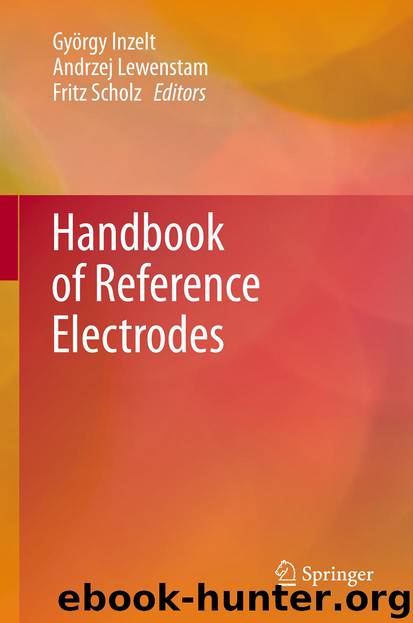Handbook of Reference Electrodes by György Inzelt Andrzej Lewenstam & Fritz Scholz

Author:György Inzelt, Andrzej Lewenstam & Fritz Scholz
Language: eng
Format: epub
Publisher: Springer Berlin Heidelberg, Berlin, Heidelberg
(6.1)
(6.2)
In Eq. (6.1), t is the ionic transport number, a is the electrolyte activity, and the subscripts 1 and 2 refer to the left and right sides of the junction. E j(a) = 0 for . In Eq. (6.2), is the standard Gibbs energy of transfer of i from solvent S1 to S2, and is equal to the difference in the standard chemical potential of i, , in S1 and S2.
Linear relations of unit slopes are generally observed between the actual (experimental) variations in component (a) and the values obtained by Eq. (6.1) (Fig. 6.4). Thus, Eq. (6.1) is applicable to estimate the values of component (a). The magnitudes are of the order of ±40 mV for the variation in electrolyte concentrations (c 1/c 2, mM) from 100/1 to 1/100.
Fig. 6.4Actual variation in component (a) versus component (a) calculated by Eq. (6.1). Junctions c 1 MX(S1)¦c 2 MX(S2). S1/S2, and M/X are shown on the lines and W, M, DS, and Et show H2O, MeOH, DMSO and Et4N, respectively; (c 1, c 2)/mM are, from left to right, (100, 1), (10, 1), (1, 1), (1,10), (1, 100); filled diamond (25, 25). Lines have unit slopes. The relation for “W/DS, Et/ClO4” deviates from linearity, but this is due to the influence of the electrolyte concentration on component (c)
Download
This site does not store any files on its server. We only index and link to content provided by other sites. Please contact the content providers to delete copyright contents if any and email us, we'll remove relevant links or contents immediately.
Alchemy and Alchemists by C. J. S. Thompson(3298)
The Elements by Theodore Gray(2854)
The Club by A.L. Brooks(2748)
How to Make Your Own Soap by Sally Hornsey(2744)
Drugs Unlimited by Mike Power(2486)
Wheels of Life by Anodea Judith(1921)
Cracking the Sat French Subject Test, 2013-2014 Edition by The Princeton Review(1768)
Perfume by Jean-Claude Ellena(1742)
The Flavor Matrix by James Briscione(1715)
Cracking the LSAT, 2012 Edition by Princeton Review(1694)
The Cosmic Machine: The Science That Runs Our Universe and the Story Behind It by Scott Bembenek(1693)
MCAT Physics and Math Review by Princeton Review(1568)
1000 Multiple-Choice Questions in Organic Chemistry by Organic Chemistry Academy(1568)
The Thing Around Your Neck by Chimamanda Ngozi Adichie(1488)
Cracking the SAT Premium Edition with 6 Practice Tests, 2017 by Princeton Review(1480)
Handbook of Modern Sensors by Jacob Fraden(1479)
A is for Arsenic: The Poisons of Agatha Christie (Bloomsbury Sigma) by Kathryn Harkup(1457)
Synchrotron Light Sources and Free-Electron Lasers by Eberhard J. Jaeschke Shaukat Khan Jochen R. Schneider & Jerome B. Hastings(1455)
Harry Potter All Books: 8 Books by J.k.rowling(1437)
